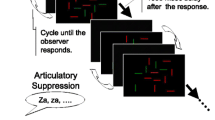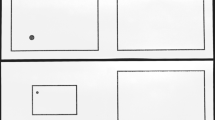Abstract
The present study was designed to assess whether the visibility of ones’ own exploratory movements impairs or enhances perceptual speed and precision of haptic stimuli with varying complexity. Previous studies have shown that noninformative vision of steady surroundings improves haptic spatial perception. However, due to the serial nature of haptic processing and limited capacity of working memory resources, we hypothesized that noninformative vision of limb movements may impair haptic perception. The study sample consisted of ninety-eight healthy adults who were randomized into two groups, matched for sex and age. Participants were required to explore two-dimensional haptic stimuli with varying complexity and to recognize them visually. The difference between the two experimental groups was a screen that would prevent the participants from viewing their hands during exploration in the nonobservation condition (NonOb). The other half of participants were able to see their hands in the manual movement observation condition (MovOb) thanks to the special design of the stimuli. As hypothesized, the persons in the MovOb condition made significantly more errors. The difference in error frequency between participants of the MovOb and NonOb condition was greater for complex stimuli than for simple ones. These results suggest that incoming visual information about own manual exploration movements increases competitive pressure for limited working memory resources, and therefore, more recognition errors are made. Covering the hands during exploration may constitute a helpful simplification of the task’s demands by supporting the maintenance of information in working memory. Additionally, the relation of haptic complexity and stimulus characteristics was analyzed.




Similar content being viewed by others
References
Attneave F (1957) Physical determinants of the judged complexity of shapes. J Exp Psychol 53:221–227
Awh E, Jonides J, Reuter-Lorenz PA (1998) Rehearsal in spatial working memory. J Exp Psychol Hum Percept Perform 24:780–790
Ballesteros S, Reales JM (2004) Visual and haptic discrimination of symmetry in unfamiliar displays extended in the z-axis. Perception 33:315–327
Brennan MJ, Allen D, Aleman D, Azmitia EC, Quartermain D (1984) Age-differences in within-session habituation of exploratory-behavior—effects of stimulus complexity. Behav Neural Biol 42:61–72
Diao FF, Sundar SS (2004) Orienting response and memory for web advertisements: exploring effects of pop-up window and animation. Commun Res 31:537–567
Eng HY, Chen DY, Jiang YH (2005) Visual working memory for simple and complex visual stimuli. Psychon Bull Rev 12:1127–1133
Ernst MO, Banks MS (2002) Humans integrate visual and haptic information in a statistically optimal fashion. Nature 415:429–433
Ernst MO, Bulthoff HH (2004) Merging the senses into a robust percept. Trends Cogn Sci 8:162–169
Gaschk JA, Kintz BL, Thompson RW (1968) Stimulus complexity free looking time and inspective exploration. Percept Psychophys 4:319–320
Grunwald M (2010) Haptic Pad’s: Eine neue Methode zur Messung und zum Training haptischer Wahrnehmungsleistungen. Manuelle Medizin 6:474–476
Grunwald M, Weiss T, Krause W, Beyer L, Rost R, Gutberlet I, Gertz HJ (1999) Power of theta waves in the EEG of human subjects increases during recall of haptic information. Neurosci Lett 260:189–192
Grunwald M, Weiss T, Krause W, Beyer L, Rost R, Gutberlet I, Gertz HJ (2001) Theta power in the EEG of humans during ongoing processing in a haptic object recognition task. Cogn Brain Res 11:33–37
Harris JA, Arabzadeh E, Moore CA, Clifford CWG (2007) Noninformative vision causes adaptive changes in tactile sensitivity. J Neurosci 27:7136–7140
Hershberger WA, Misceo GF (1996) Touch dominates haptic estimates of discordant visual-haptic size. Percept Psychophys 58:1124–1132
Hillis JM, Ernst MO, Banks MS, Landy MS (2002) Combining sensory information: mandatory fusion within, but not between, senses. Science 298:1627–1630
Igarashi Y, Kitagawa N, Ichihara S (2010) Influence of the body on crossmodal interference effects between tactile and two-dimensional visual stimuli. Exp Brain Res 204:419–430
Klatzky RL, Lederman S, Reed C (1987) Theres more to touch than meets the eye—the salience of object attributes for haptics with and without vision. J Exp Psychol Gen 116:356–369
Knecht S, Kunesch E, Schnitzler A (1996) Parallel and serial processing of haptic information in man: effects of parietal lesions on sensorimotor hand function. Neuropsychologia 34:669–687
Kreitler S, Zigler E, Kreitler H (1974) Complexity of complexity. Hum Dev 17:54–73
Lang A (2000) The limited capacity model of mediated message processing. J Commun 50:46–70
Lawrence BM, Myerson J, Oonk HM, Abrams RA (2001) The effects of eye and limb movements on working memory. Memory 9:433–444
Locher PJ, Simmons RW (1978) Influence of stimulus symmetry and complexity upon haptic scanning strategies during detection, learning, and recognition tasks. Percept Psychophys 23:110–116
Lynn R (1966) Attention, arousal, and the orientation reaction. Pergamon, Oxford
Montague A (1978) Touching—the human significance of the skin. Harper & Row, New York
Newport R, Rabb B, Jackson SR (2002) Noninformative vision improves haptic spatial perception. Curr Biol 12:1661–1664
Postle BR, Idzikowski C, la Sala S, Logie RH, Baddeley AD (2006) The selective disruption of spatial working memory by eye movements. Q J Exp Psychol 59:100–120
Rosen B, Bjorkman A (2010) Momentary improvement of hand sensibility by excluding vision. J Plast Surg Hand Surg 44:302–305
Rosler F, Roder B, Heil M, Hennighausen E (1993) Topographic differences of slow event-related brain potentials in blind and sighted adult human-subjects during haptic mental rotation. Cogn Brain Res 1:145–159
Smyth MM, Scholey KA (1994) Interference in immediate spatial memory. Mem Cogn 22:1–13
Tastevin J (1937) Starting from Aristotle’s experiment the artificial displacements of parts of the body are not followed by feeling in these parts or by the sensations which can be produced there. L’Encéphale: Revue de psychiatrie clinique biologique et thérapeutique 32:57–84
Taylor-Clarke M, Kennett S, Haggard P (2004) Persistence of visual-tactile enhancement in humans. Neurosci Lett 354:22–25
Wallraven C, Whittingstall L, Bülthoff HH (2013) Learning to recognize face shapes through serial exploration. Exp Brain Res 226(4):513–523. doi:10.1007/s00221-013-3463-y
Acknowledgments
This research project was supported in part by the Deutsche Forschungsinitiative Eßstörungen (DFE e.V.) and the Haptik-Forschungszentrum. Neither had influence on the preparation of the article nor the conduct of the research.
Conflict of interest
None.
Author information
Authors and Affiliations
Corresponding author
Rights and permissions
About this article
Cite this article
Mueller, S., Habermann, S., Dudda, J. et al. Observation of own exploration movements impairs haptic spatial perception. Exp Brain Res 231, 415–423 (2013). https://doi.org/10.1007/s00221-013-3706-y
Received:
Accepted:
Published:
Issue Date:
DOI: https://doi.org/10.1007/s00221-013-3706-y




